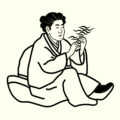Kireji (切れ字), or cutting words, are essential components of traditional Japanese poetry, including haiku and renga. They contribute to the structure, rhythm, and emotional depth of the verses, adding nuance and complexity to the poems. One such kireji is “shi” (し), which is often associated with assertion. Here, we’ll explore the “shi” kireji, its role in Japanese poetry, and its significance for those who do not speak Japanese.
Contents
The Role of “Shi” (し) in Japanese Poetry
The “shi” kireji is used to emphasize a point or to make a statement more forceful. When “shi” is incorporated into a verse, it can create a sense of affirmation or assertion, allowing the reader to share the poet’s strong convictions or feelings.
Examples of “Shi” (し) in Haiku
To better understand the use and impact of the “shi” kireji, let’s examine examples of its use in haiku, a traditional Japanese poetic form consisting of three lines and 17 syllables (5-7-5). Here are a few examples of haiku featuring the “shi” kireji:
“The Rains of Summer” – Matsuo Bashō (1644-1694):
五月雨を あつめてはやし 最上川
Samidare wo atsumete hayashi mogamigawa
The rains of summer join together –
How swift it is
Mogami River
“Deep Silence” – MatsuoBasho
閑かさや 岩にし み入る 蝉の声
Shizukasa ya iwa ni shimiiru semi no koe
deep silence –
the shrill of cicadas
seeps into rocks
*Update: To make it a little easier to see where Shi sits in these haiku, I have broken them up via spacing and bolding. I’m sure any native Japanese readers are cringing at that break-up, and I wholly apologise, but it does help to make it a little easier to see. Remember, you’re looking for the symbol – “し” as a representation of Shi.
Understanding “Shi” (し) for Non-Japanese Speakers
For non-Japanese speakers interested in traditional Japanese poetry, it is essential to understand the role of kireji like “shi.” When reading a haiku or renga translated into another language, the “shi” kireji may not be explicitly present, but its effect should still be apparent in the translation. The translator should convey the sense of assertion or emphasis that “shi” imparts to the verse.
“Shi”, is often used as an adjectival suffix, bring a clause to an end and allowing the reader a momentary pause before moving on to the rest of the haiku. This dividing line acts as a key reference point for the reader, forcing the “two halves” of a haiku into their own sections, allowing for easier reading and simpler comparisons.
Yes, for those haiku experts in the crowd, I’m aware that is a gross simplification of their role, but at their core, I’d argue that is probably their primary role in haiku.
Of course, it is worth remembering that kireji aren’t actually translatable as a sound into English versions of these poems. Similarly, the closest we could come to them verbally would be to naturally structure our haiku so that the syntax of our lines forced the reader to temporarily pause.
How Could You Replicate “Shi” in English Language Poetry or Translation?
I’ve included a few examples of how you might be able to replicate the use of し in your poems, whether you’re writing for yourself or translating someone else’s work.
Punctuation:
As you can see in the two haiku above, shi is most often represented in haiku through the use of punctuation. In these instances, we can see the use of “-” performing the same role as shi. Each dash, “-“, breaks up the haiku and signifies the movement on to the next stage of its composition. This not only forces the reader to momentarily pause, but gives us a clear opportunity to segment the haiku in our heads, allowing us to naturally seek the essential comparison or contrast between the two sections.
It is worth noting that, while the dash has been used in these haiku, that doesn’t mean it’s the default. You can see punctuation used in all kinds of ways when it comes to English language haiku, and there’s as much variety there as you’ll find in Japanese haiku.
For example, in addition to the dash, you could use full stops to create fragmented sentences. This will heavily impact your pacing, but it can be extremely powerful.
Similarly, you could rely on ellipses “…”, exclamation marks, or even questions marks to pose rhetorical questions of your reader. Again, I think it’s worth going into more detail about each of these potential use cases, as they can all completely change how your haiku is percieved.
Enjambment:
What you’ll see less often in place of kireji is enjambment. As we’re all taught, in English, to break Haiku into three lines of varying syllable length, the use of enjambent to split a haiku into two sections isn’t that effective. However, enjmbment in haiku does have other benefits; ones which are incredibly useful and powerful when used correctly. I’ll go into this shortly in another article, as I think there’s too much to say on the subject here.
Unusual Adjective-Noun Pairings:
Syntactically, you could use adjectives and nouns which don’t pair together normally. Any strange or unique use of language can be a great way to not only make the reader pause, but also to fix your lines in the readers mind. We naturally remember outliers and things that don’t quite match up, similar to how we can remember rhythms and rhyming patterns easier than unconsidered text.
- Glossary of Japanese Poetry Terms - 26 February 2025
- What is Waka Poetry? - 23 May 2024
- How to Identify the Kigo in a Haiku: - 22 March 2024






1 Comment
owen
10 October 2023maybe I’m missing something, but neither of these haiku have し in them.